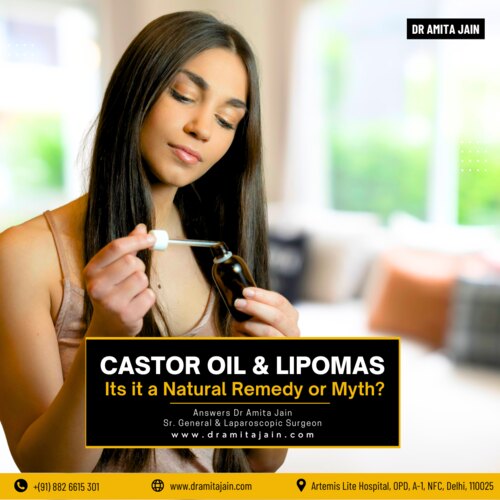We rarely stop to appreciate our health until life’s pace forces us to. In the daily scramble of work, family, and a mountain of other tasks, we often overlook what keeps us moving. Many say that health is our most valuable asset—it’s what carries us through the ups and downs, even when unexpected challenges crop up. And then, there are moments when things are simply out of our control—like when lipomas show up.
These lipomas are those benign fatty lumps that form just below our skin, usually nestling between the skin and the underlying muscles. They feel soft to the touch, can be shifted around a bit, and usually don’t cause pain. Still, they can sometimes grow to a size that starts to bother you. Although surgery tends to be the standard fix, many people are exploring alternative, natural approaches to shrink or get rid of these bumps, with castor oil being one option that keeps coming up in conversation.
Here, we’re trying to understand whether castor oil can truly help with lipomas or if it’s just another myth that’s been passed around. Let’s find out from Dr Amita Jain, India’s top laparoscopic surgeon and doctor for lipoma treatments in this blog.

Why Do Lipomas Occur?
Now that we know what Lipomas are, let us understand the cause of lipoma formation. While the exact cause of lipomas isn’t fully understood, they are believed to be linked to a combination of genetic factors, trauma, and possibly certain medical conditions like diabetes, obesity, lipid metabolism disorder, etc. It usually occurs in people belonging to the age group of 40-60. Alterations in fat metabolism, tissue structure, or conditions associated with aging may also play a role.
Why Castor Oil? Castor oil contains one main component: ricinoleic acid. It’s believed to:
- Reduce inflammation
- Improves blood flow
- Support healing
How is castor oil proposed to work on a lipoma?
- Soften the lump
- Make it less visible
- Possibly shrink it over time
But here’s the truth:
However, there’s no solid scientific evidence that castor oil can shrink or eliminate lipomas. Yet many people try it, since it’s economical, hassle free, and readily available.
Two Popular Ways to Use Castor Oil for Lipomas
Topical Massage Method
- Gently warm some cold-pressed castor oil
- Gently rub it on swelling soft lipomas and other nearby skin
- Massage the affected area in a circular motion for 5–10 minutes
- Do this 2–3 times a day
- Stay consistent for weeks or months
Castor Oil Pack Method
- Soak a clean cloth in warm castor oil
- Place the cloth over the lipoma
- Cover it with plastic wrap
- Put a hot water bottle or heating pad on top
- Leave it for 30 to 60 minutes
- Try this 3–5 times a week
Feedback From Patients
According to some users, castor oil application did reduce the size of lipomas, softened the lump and in rare cases small lipomas even disappeared completely. However, others noticed no significant change even after months; some improvement that faded once they stopped applying castor oil and occasional skin irritation from frequent use.
However, there is no scientific explanation to support it. Lipomas are basically soft, fatty lumps made up of fat cells, all wrapped up in a thin, fibrous layer. When you apply castor oil on your skin, it just doesn’t go deep enough to reach or break down those fat cells. At best, it might make the skin feel a little softer or reduce some surface-level inflammation, but it’s unlikely to actually shrink the lipoma.
That said, if using castor oil gives you comfort or relief, there’s no harm in it. Just don’t expect it to be a magic fix. If your lipoma is bothering you or growing, it’s always best to talk to a doctor and explore your options.
- Get a proper diagnosis: Consult your doctor to confirm that the lump is a lipoma and not something more serious.
- Do a patch test first: Apply a small amount of castor oil to your inner forearm and wait 24 hours to check for any allergic reaction.
- Choose quality oil: Use only cold-pressed, hexane-free castor oil for best safety and effectiveness.
- For external use only: Never ingest castor oil, especially not for treating lipomas.
- Avoid during pregnancy: Pregnant women should not use castor oil packs, even topically.
- Track your starting point: Take photos and measure the size of the lipoma to monitor progress.
- Create a consistent routine: Develop an easy-to-follow application schedule that you can stick with.
- Keep a treatment journal: Note any changes—positive or negative—to assess how your body is responding.
- Set realistic expectations: Allow at least 3 to 6 months to see if there’s any improvement.
- Watch for irritation: Discontinue use immediately if you notice redness, itching, or discomfort.
- Stay under medical supervision: Keep your doctor informed and schedule regular check-ups.
— Have a backup plan: Be prepared to explore medical treatment if castor oil doesn’t bring the desired results.
Final Decision Now that you are aware of both the hope and the hype around castor oil for lipomas, remember—natural remedies can offer comfort but not always a cure. If it eases your mind or symptoms, go ahead gently. Just stay realistic, track your progress, and always keep your doctor in the loop.

Dr Amita Jain is a surgeon with the highest degree of professional competence, precision and surgical craftsmanship. Performed all complicated general surgery procedures with in depth knowledge of invasive and few minimal invasive and onco surgical techniques. Underwent special training in trauma, executed various trauma-related complex life-saving neurosurgical procedures, reconstructed injured mangled limbs and performed vascular and reconstructive procedures with critical care.
Dr Amita Jain holds 28 plus years of rich experience in Trauma and General Laparoscopic Surgeries (including Gallbladder stone removal, appendix removal, hernia repair surgery, piles and fissure surgeries). She was the Professor Surgery of at the Army College of Medical Sciences and Base Hospital Delhi Cantt. In 1994 she was commissioned as Surgeon under the United Nations Mission in Congo. From 2020 to 2022, she worked with Bansals Hospital. Currently, Dr Amita Jain is the Senior Consultant, (Speciality: General and Laparoscopic Surgeon) at Artemis Lite Hospital, New Delhi and Sr. General and Laparoscopic Surgeon at Rainbow Children Hospitals, Malviya Nagar, Delhi.